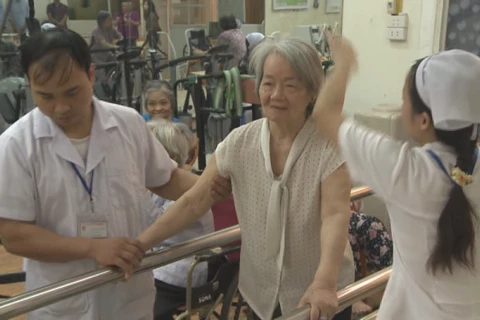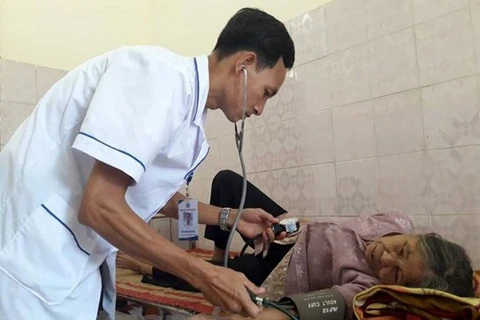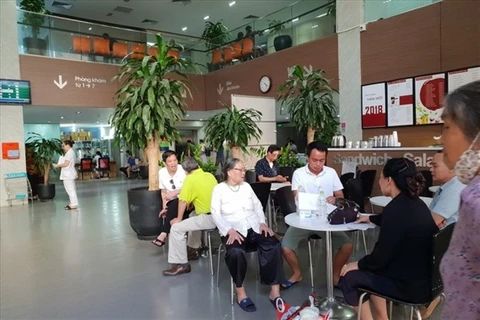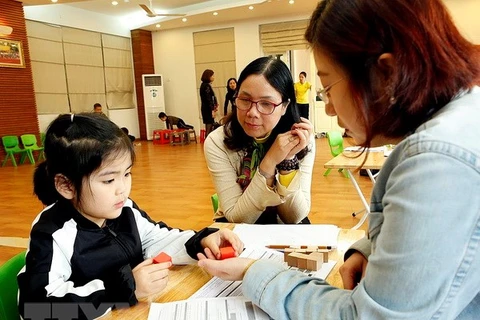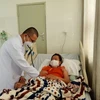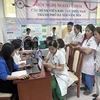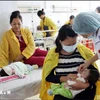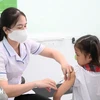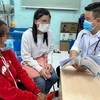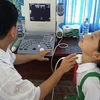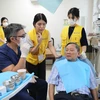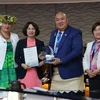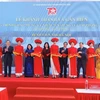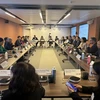 Old women do morning exercises at Hoan Kiem Lake. As the Vietnamese population gets older, more money needs to be spent on health, experts said (Photo: VNA)
Old women do morning exercises at Hoan Kiem Lake. As the Vietnamese population gets older, more money needs to be spent on health, experts said (Photo: VNA) Hanoi (VNS/VNA) - Global trends in health policies and practical access in the context of the rapidly aging population were topics of discussion at a forum on health care on November 13 in Hanoi.
The forum was titled “Paving the path for the future in healthcare: Driving efficiency and outcomes in a rapidly aging Asia” and was organised by the Vietnam Medical Association and Novartis Vietnam. It drew the participation of dozens of healthcare policymakers and academic leaders in the healthcare sector from across Asia.
According to Amos Garcia from Singapore’s Milken Institute, the challenges of ageing societies were enormous as older people are increasing in number.
Research by the institute showed that Asia was ageing faster than it was gaining wealth.
The Healthcare sector’s share of GDP has been rising in East Asia and the Pacific with income growth, he said.
Speaking at the forum, Nguyen Van Tien, former deputy head of the National Assembly’s Committee for Social Affairs, said Vietnam is among the countries with the fastest growing aging populations in Asia.
While developed countries like France takes 115 years to transform from an ageing population into an old or aged population, the process only takes 18 years for Vietnam.
As the Vietnamese population ages, more money would be spent on healthcare, he said, adding that health expenditure accounted for 5.7 percent of its GDP in 2015.
The number of dependent elderly people who need care was increasing while the population of young labourers paying taxes was reducing.
Tien said the burden on the health system would only grow as the population gets older.
He proposed re-orienting the system to respond to an increase in non-communicable diseases and the ageing population. Universal healthcare coverage for people of all ages would be continued as will the development of private health services.
To overcome the negative impacts of an ageing population, Garcia said it was necessary to redefine traditional notions of ageing. This includes reinforcing the message that older adults are valuable to society. A top-down corporate culture that recognizes the wisdom, knowledge and opportunities of older workers should be emphasised.
Another solution was to provide opportunities for meaningful and productive experiences and focus on long-term wellness and disease prevention, he said.
He underlined the need to remove age-related institutional barriers to social participation.
Regarding challenges to universal health coverage, Le Van Kham, Director of the Health Insurance Department under the Vietnamese Ministry of Health, said 13 percent of the population was uninsured. The rate of out-of-pocket spending was at 40 percent, but World Health Organisation recommendations saidit should be less than 30 percent.
He said "limited financial resources mean that resources are not always used efficiently".
The capacity of health service provisions was weak, especially at the provincial level, which limited benefits for beneficiaries, increasing costs for patients, Kham said.
To solve these difficulties, he suggested a dissemination campaign and making benefits more favourable for health insurance holders.
Prastoeti Soewondo from office of the vice president of the Republic of Indonesia served as a member of the supervisory board of the National Social Health Insurance Agency until 2015 and now sits on the country’s health working group. She said remarkable results had been achieved since the integration of the health insurance scheme into single payer - JKN (Jaminan Kesehatan Nasional), a scheme operated by Badan Panyelenggara Jaminan Sosial Kesehatan (BPJS) in 2014.
Under JKN, a government-subsidised scheme, all citizens are able to access a wide range of health services provided by public facilities, and services from a few private providers that opted to join the scheme.
Analysts have pointed out that from 2013 to 2016, the utilisation of both outpatient and an inpatient services is consistently higher among JKN members compared to uninsured people. From 2013 to 2016, inpatient utilization for JKN member increased by 68.7 percent and in 2016 was 1.6 more than that of the uninsured, she said.
Reforms in payment systems and the drug supply chain resulted in a comprehensive benefit package with almost all diseases covered, Soewondo said.
“Universal coverage is ‘beyond treatment,’” she said. “It should be a holistic approach embedded in a strong health care system.”
Participants at the forum agreed that patient should be the centre of the health sector and community. They said the public and patients should be engaged in disease prevention and management.
Given the increasing challenges in the health care system, new technologies and digitalisation should be adopted to enhance the quality of patient care and enable sustainable development, they said.-VNS/VNA
VNA
